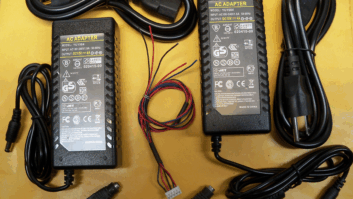Harris Broadcast and WOR(AM) say they’ve had success with a power-saving Modulation-Dependent Carrier Level algorithm at WOR, with no effect on Arbitron Portable People Meter data encoding/decoding, HD Radio signal coverage or digital audio quality.

The meter reading of about 38 kW is the approximate average power level reading of a 50 kW transmitter after the AMC (–3 dB) MDCL algorithm was turned on. Normally the meter would read 50 kW.
MDCL algorithms have been used by broadcasters operating high-powered AM transmitters in Europe for a number of years. Carrier control algorithms for AM transmitters enable stations to save money on operating costs by reducing the carrier without reducing overall transmitter power. Recently the FCC began allowing AMs to use the power-saving technology on a waiver basis.
According to Harris Broadcast Vice President of Transmission Research & Technology Geoff Mendenhall, the commission is taking a case-by-case approach to waiving the rule that a station must maintain authorized power levels. He said the agency doesn’t want to encourage struggling AMs that might otherwise be tempted to try to save money by lowering power and reducing coverage, as an alternative to going dark.
Harris engineers worked with Tom Ray, corporate director of engineering at Buckley Broadcasting/WOR(AM) in New York, to test the compatibility of two Harris MDCL algorithms.
Engineers tested Harris algorithms for Amplitude Modulation Companding (AMC) with a carrier reduction level of 3 dB at peak modulation, and Adaptive Carrier Control (ACC) at carrier reductions of 2dB, 3dB and 6dB at minimum modulation. AMC reduces the carrier level during segments when modulation levels are high; ACC reduces the carrier level during segments when audio modulation levels are low.ACC plus reduces the carrier level during segments when audio modulation levels are low, while AMC plus reduces the carrier level during segments when modulation levels are high.
WOR at 710 kHz is 50 kW both day and night, and uses a pair of Harris 3DX-50 transmitters feeding a three-tower directional antenna array. It had the MDCL option installed on both transmitters. The station’s programming is mostly talk radio with moderately to heavily processed audio.
Through testing that began in late November, participants found that AMC was the most compatible with simultaneous HD Radio operation, causing no noticeable change in HD Radio coverage, according to Harris and WOR. AMC also provided the largest reduction in transmitter power consumption, by saving 37 percent in average AC power input to the transmitter.

The Fluke 434 power quality analyzer was used to measure the actual total AC power consumption of the transmitter with and without MDCL applied. The Sony ICF-SW7600 portable receiver was one of the receivers used to check for audio quality and coverage with the MDCL switched on and off.
Ray estimated this translates up to a $3,000 per month savings on the electric bill at his New Jersey transmitter site. As RW has reported, Nautel, another MDCL proponent, has estimated that a 50 kW AM transmitter running 24/7 could easily save $20,000 a year or more, based on modest electricity rates of 10 cents per kilowatt hour.
Testing MDCL compatibility with PPM was vital, Mendenhall said. That’s because if a station’s PPM encoding is impaired, the station doesn’t get listening credit while the encoding is not working.
During testing, WOR called the Arbitron PPM monitoring station in New York, which assured the station the PPM encoding/decoding was not affected by the power-saving technology, according to Ray and Mendenhall.
AMC remains on the air at WOR and Ray intends to keep it operating. During testing, the AMC was shut off every three hours so personnel could take carrier power measurements. Ray said WOR’s carrier is only running at around 26 kilowatts of power with AMC, compared to 52.560 kilowatts of power normally.
WOR also tried the Adaptive Carrier Control algorithm, but the analog audio quality was affected, the digital signal was “destroyed” and the power reduction was only about 16 percent, according to Ray. “It sounded horrendous,” though he said this doesn’t mean it wouldn’t work for an AM with a different type of format.
Indeed, Mendenhall said ACC gives a user the greatest power savings with formats whose levels are not running at peak all the time, such as a lightly processed music format. In contrast, WOR’s talk levels are processed heavily.
In ACC mode, if the format pauses are long enough, the automatic gain control in the receiver will start to turn up the gain in the radio, which can cause the HD to unlock, and blend back to analog, according to Mendenhall. Such HD dropouts did happen on WOR with ACC. In contrast, with AMC turned on “we never saw any HD dropouts,” he said.

From left: Tom Ray, corporate director of engineering at Buckley Broadcasting/WOR(AM) in New York, and Harris personnel Terry Cockerill, systems engineer; Geoff Mendenhall, vice president, transmission research and technology; and Brian Szewczyk, district sales manager.
Listening tests at weak signal areas on several types of receivers with digital, analog and synchronous AM detectors showed no noticeable loss of audio quality. During drive tests with AMC turned on and off repeatedly, Ray said WOR actually was louder in fringe areas.
We recently reported that Crawford Broadcasting received a waiver to test MDCL algorithms on station KCBC(AM), San Francisco. The station, which operates at 50 kW power daytime and 4.1 kW night, planned to test using a Nautel NX50 transmitter, according to Crawford Director of Engineering Cris Alexander. That system supports the AMC algorithm as well as Dynamic Amplitude Modulation. DAM reduces the carrier amplitude at lower modulation depths where the full amplitude is not required to prevent negative peak distortion. The audio level is not adjusted, so this has the side effect of increasing audio volume at low modulation depths out of the receiver. There is also a corresponding decrease in signal-to-noise ratio at low modulation depths.







